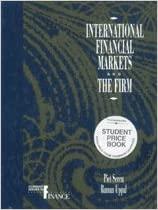Question
Introduction The mean-variance relationship has long been a focus in finance literature. Traditional financial theories propose a positive mean-variance relationship, or risk-return tradeoff (Merton, 1973),
Introduction
The mean-variance relationship has long been a focus in finance literature. Traditional financial theories propose a positive mean-variance relationship, or risk-return tradeoff (Merton, 1973), i.e. bearing high (low) risk should be rewarded by high (low) returns, empirical studies document at best inconclusive evidence with three mainstreams due to different economic settings and volatility model selection. French et al. (1987), Scruggs (1998), Ghysels et al. (2005), Lundblad (2007), Pstor et al. (2008), Brandt and Wang (2010), and Rossi and Timmermann (2015), among others find the risk-return tradeoff despite being less significant in some cases. On the other hand, Nelson (1991), Brandt and Kang (2004), Baker et al. (2011), Fiore and Saha (2015), and Booth et al. (2016), among others, document a negative mean-variance relationship. Turner et al. (1989), Glosten et al. (1993), Sun et al. (2017), and Wang et al. (2017), among others, report both positive and negative relationship between risk and returns.
A wide range of theories are proposed to explain the weak risk-return tradeoff, such as investor sentiment (Yu and Yuan, 2011; Wang, 2018a&b; Wang and Duxbury, 2021) and differences in overnight and intraday returns (Wang, 2021).
In line with the above, answer the following requirements:
question 6 Examine the mean-variance relation for (i) overnight returns, (ii) intraday returns, and (iii) total returns. Interpret. [25 marks]
Requirement 6:
- Examine the mean-variance relation for three returns.
- Interpret.
Step by Step Solution
There are 3 Steps involved in it
Step: 1

Get Instant Access to Expert-Tailored Solutions
See step-by-step solutions with expert insights and AI powered tools for academic success
Step: 2

Step: 3

Ace Your Homework with AI
Get the answers you need in no time with our AI-driven, step-by-step assistance
Get Started


